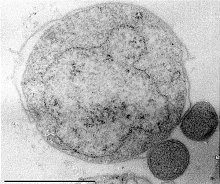Nanoarchaeum equitans
| Nanoarchaeum equitans | ||||||||||
|---|---|---|---|---|---|---|---|---|---|---|

Ignicoccus hospitalis with attached Nanoarchaeum equitans |
||||||||||
| Systematics | ||||||||||
|
||||||||||
| Scientific name | ||||||||||
| Nanoarchaeum equitans | ||||||||||
| Huber et al. , 2002 |
Nanoarchaeum equitans is a 400 nm wide unicellular living being from the group of archaea , the symbiotic or parasitic lives on other archaea. The microorganism was discovered in 2002 in the laboratory of Karl O. Stetter at the University of Regensburg . The genome was completely sequenced 17 months later. So far Nanoarchaeum equitans the only known representative of the department "Nanoarchaeota", but it has not yet formally valid described was, therefore all systematic names in quotation marks.
The organism was given the name Nanoarchaeum equitans (“the riding primeval dwarf”) because of its small size and because it attaches itself to other archaea. It has not yet been clarified whether this is a symbiosis or a parasitism. An advantage for the host Ignicoccus hospitalis has not yet been discovered.
The genome of Nanoarchaeum equitans is very small with only 490 kilobase pairs . It is the second smallest genome of a microorganism described so far and at the same time one of the most compact, only that of Carsonella ruddii is even smaller at approx. 160 kbp. 95 percent of the genome code for proteins or RNAs , so the proportion of functionless genes (“ pseudogenes ”) is low. However, Nanoarchaeum equitans is not able to produce all the substances it needs for life itself and is therefore dependent on a host organism.
Nanoarchaeum equitans is an extremophilic organism, it can only exist below 70–110 ° C, sulfur-containing, oxygen-free conditions, such as those that prevailed on earth about 3.8 billion years ago . Today, for example, such an environment exists in the deep sea at hydrothermal chimneys such as black smokers .
literature
- MJ Hohn, BP Hedlund, H. Huber: Detection of 16S rDNA sequences representing the novel phylum “Nanoarchaeota”: indication for a wide distribution in high temperature biotopes. In: Syst Appl Microbiol. , 2002 Dec; 25 (4), pp. 551-554, PMID 12583716 .
- H. Huber, MJ Hohn, R. Rachel, T. Fuchs, VC Wimmer, KO Stetter: A new phylum of Archaea represented by a nanosized hyperthermophilic symbiont. In: Nature , 2002 May 2; 417 (6884), pp. 63-67, PMID 11986665 .
- H. Huber, MJ Hohn, KO Stetter, R. Rachel: The phylum Nanoarchaeota: present knowledge and future perspectives of a unique form of life. In: Res Microbiol. , 2003 Apr; 154 (3), pp. 165-171, PMID 12706504 .
- NR Thomson, M. Sebaihia, AM Cerdeno-Tarraga, MT Holden, J. Parkhill: Shrinking genomics. In: Nat Rev Microbiol . 2004 Jan; 2 (1), p. 11, PMID 15035003 .
- E. Waters, MJ Hohn, I. Ahel, DE Graham, MD Adams, M. Barnstead, KY Beeson, L. Bibbs, R. Bolanos, M. Keller, K. Kretz, X. Lin, E. Mathur, J. Ni, M. Podar, T. Richardson, GG Sutton, M. Simon, D. Soll, KO Stetter, JM Short, M. Noordewier: The genome of Nanoarchaeum equitans: insights into early archaeal evolution and derived parasitism. In: Proc Natl Acad Sci USA . 2003 Oct 28; 100 (22), pp. 12984-12988, Epub 2003 Oct 17, PMID 14566062 .
Individual evidence
- ↑ Harald Huber, Michael J. Hohn, Reinhard Rachel, Karl O. Stetter: Nanoarchaeota . In: The Prokaryotes , 2006, 3, pp. 274-280, DOI: 10.1007 / 0-387-30743-5 14
- ↑ J. Tamames, R. Gil, A. Latorre, J. Peretó, FJ Silva, A. Moya: The frontier between cell and organelle: genome analysis of Candidatus Carsonella ruddii. In: BMC Evolutionary Biology. Volume 7, 2007, p. 181, doi : 10.1186 / 1471-2148-7-181 , PMID 17908294 , PMC 2175510 (free full text).